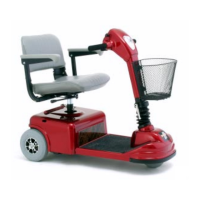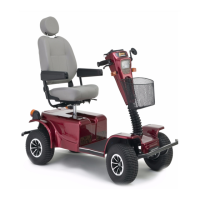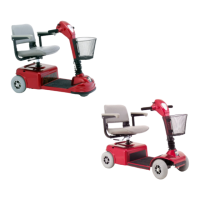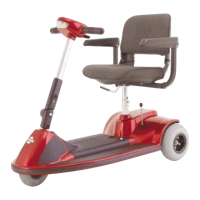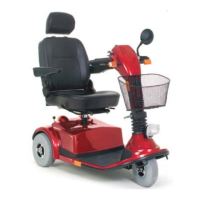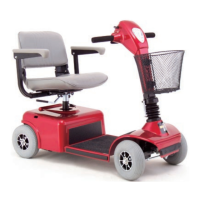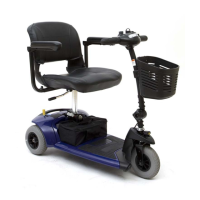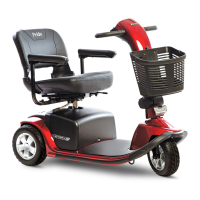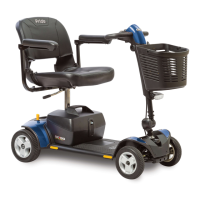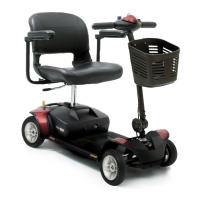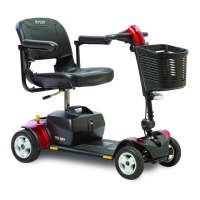Do you have a question about the Pride Mobility raptor series and is the answer not in the manual?
Summarizes general safety warnings, precautions, and notes found in the manual.
Explains the meaning and usage of various warning symbols presented in the manual.
Lists specific inspection points to ensure the scooter is safe and ready for operation.
Details the different braking mechanisms of the scooter, including regenerative and hand brakes.
Lists and identifies all buttons, switches, and levers on the tiller console.
Details the operation of the hi-low switch, forward-reverse switch, and throttle lever.
Explains the function and use of the handbrake, parking brake, and horn buttons.
Explains how to use turn signals, run lights, and switch headlights.
Describes the data displayed on the scooter's LCD screen, including speed and battery status.
Explains the scooter's speed indicator, battery condition meter, and odometer/tripometer.
Locates the off-board charger port and explains the function of electrical system fuses.
Provides instructions on how to adjust the tiller height and mirror positions.
Explains how to engage and disengage the manual freewheel lever for pushing the scooter.
Describes the motor/transaxle assembly, anti-tip wheels, and rear storage areas.
Explains where batteries are located and the role of the main circuit breaker.
Explains how to interpret the battery condition meter on the tiller console.
Lists essential safety warnings and prohibitions related to charging scooter batteries.
Illustrates the correct procedure for charging the scooter's batteries.
Addresses common user queries regarding battery charging methods and issues.
Recommends charging schedules to maximize battery life and performance.
Provides suggestions for achieving the maximum travel distance on a single charge.
Details how to choose the right batteries and perform initial break-in cycles for optimal use.
Covers safety warnings, required tools, and step-by-step procedures for changing batteries.
Visual aids showing battery changing steps and battery terminal configuration.
Provides detailed procedures for safely mounting and dismounting the scooter.
Explains how to use the throttle, steering, and braking systems to operate the scooter.
Details the correct steps for safely dismounting the scooter after use.
Explains the automatic power-off feature and how to resume operation.
Instructions on how to adjust the seatback angle for user comfort.
Details how to modify armrest width, angle, and height for optimal comfort.
Provides steps for adjusting the height of the tiller console.
Guides on installing and adjusting the scooter's mirrors for clear rear visibility.
Presents a reference guide for diagnostic fault codes and their corresponding solutions.
Provides solutions for issues where the scooter does not respond or move.
Troubleshooting for tripping circuit breakers and motor surges or hesitations.
Guidance on maintaining tire pressure and cleaning the scooter's exterior surfaces.
Instructions for inspecting and maintaining wiring harnesses and battery terminal connections.
Maintenance advice for plastic shrouds, motor brushes, and brake pads.
Details procedures for replacing fuses and the importance of using new nylon lock nuts.
Recommendations for preparing and storing the scooter for extended periods of non-use.
Summarizes general safety warnings, precautions, and notes found in the manual.
Explains the meaning and usage of various warning symbols presented in the manual.
Lists specific inspection points to ensure the scooter is safe and ready for operation.
Details the different braking mechanisms of the scooter, including regenerative and hand brakes.
Lists and identifies all buttons, switches, and levers on the tiller console.
Details the operation of the hi-low switch, forward-reverse switch, and throttle lever.
Explains the function and use of the handbrake, parking brake, and horn buttons.
Explains how to use turn signals, run lights, and switch headlights.
Describes the data displayed on the scooter's LCD screen, including speed and battery status.
Explains the scooter's speed indicator, battery condition meter, and odometer/tripometer.
Locates the off-board charger port and explains the function of electrical system fuses.
Provides instructions on how to adjust the tiller height and mirror positions.
Explains how to engage and disengage the manual freewheel lever for pushing the scooter.
Describes the motor/transaxle assembly, anti-tip wheels, and rear storage areas.
Explains where batteries are located and the role of the main circuit breaker.
Explains how to interpret the battery condition meter on the tiller console.
Lists essential safety warnings and prohibitions related to charging scooter batteries.
Illustrates the correct procedure for charging the scooter's batteries.
Addresses common user queries regarding battery charging methods and issues.
Recommends charging schedules to maximize battery life and performance.
Provides suggestions for achieving the maximum travel distance on a single charge.
Details how to choose the right batteries and perform initial break-in cycles for optimal use.
Covers safety warnings, required tools, and step-by-step procedures for changing batteries.
Visual aids showing battery changing steps and battery terminal configuration.
Provides detailed procedures for safely mounting and dismounting the scooter.
Explains how to use the throttle, steering, and braking systems to operate the scooter.
Details the correct steps for safely dismounting the scooter after use.
Explains the automatic power-off feature and how to resume operation.
Instructions on how to adjust the seatback angle for user comfort.
Details how to modify armrest width, angle, and height for optimal comfort.
Provides steps for adjusting the height of the tiller console.
Guides on installing and adjusting the scooter's mirrors for clear rear visibility.
Presents a reference guide for diagnostic fault codes and their corresponding solutions.
Provides solutions for issues where the scooter does not respond or move.
Troubleshooting for tripping circuit breakers and motor surges or hesitations.
Guidance on maintaining tire pressure and cleaning the scooter's exterior surfaces.
Instructions for inspecting and maintaining wiring harnesses and battery terminal connections.
Maintenance advice for plastic shrouds, motor brushes, and brake pads.
Details procedures for replacing fuses and the importance of using new nylon lock nuts.
Recommendations for preparing and storing the scooter for extended periods of non-use.
| Suspension | Front and rear |
|---|---|
| Tire Type | Pneumatic |
| Weight Capacity | 400 lbs |
| Battery Size | Two 12V 75AH |
| Drive System | Rear-wheel drive |
| Braking System | Regenerative and disc |
| Charger Type | Off-board |
| Weight (with SLA battery) | 330 lbs. |
| Per-Charge Range | Up to 31 miles |
| Range per Charge | Up to 31 miles |
